IELTS Listening Test: Comprehensive Guide & Strategies
The IELTS Listening Test demands active analysis and multitasking, making it a strategic component for achieving a Band 7.0+ in both Academic and General Training modules. Drawing from thousands of analyzed results, IELTS-TestPro presents this comprehensive guide to dissect the test structure, core question types, and essential strategies you need to conquer this section.
I. An overview of IELTS Listening Test
To master the test, you must first understand its architecture. The IELTS Listening Test retains a consistent format across both Academic and General Training modules, ensuring a standardized assessment of your listening capabilities.
1. Structure of the IELTS Listening Test
The test is designed to evaluate your listening skills through a progression of difficulty. It lasts approximately 30 minutes, followed by a specific period for answer transfer depending on your test mode.
- Paper-based Test: You are granted 10 minutes at the end to transfer answers to the official sheet.
- Computer-based Test: You have 2 minutes to review your answers.
- Latest Update (IELTS One Skill Retake): A significant feature now available is the IELTS One Skill Retake. If you underperform in Listening, you may now retake just this single skill at eligible centers, rather than the entire exam.
| Time allotted | Number of questions | Main content | |
| Part 1 | approx. 5 min | 10 | A daily-social conversation
(telephone call, interview, etc.) |
| Part 2 | approx. 5 min | 10 | A daily-social monologue
(presentation, radio programme, etc.) |
| Part 3 | approx. 5 min | 10 | An academic conversation
(thesis / dissertation, assignment, research project, etc.) |
| Part 4 | approx. 5 min | 10 | An academic monologue/lecture
(history, science, nature, etc.) |
2. Question Types in IELTS Listening Test
According to the official standards, candidates must master six distinct question types. Each requires a different listening strategy.
Choose one correct answer (e.g. A, B, or C) or more than one correct answer to test ability to get specific details and/or general meaning.

or
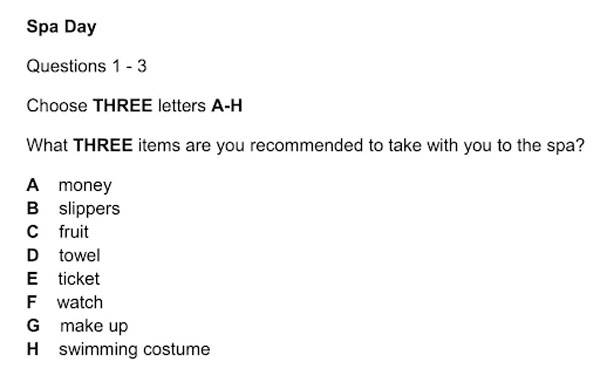
Match items from a numbered list to test listening for relationships and connections, not just single facts.
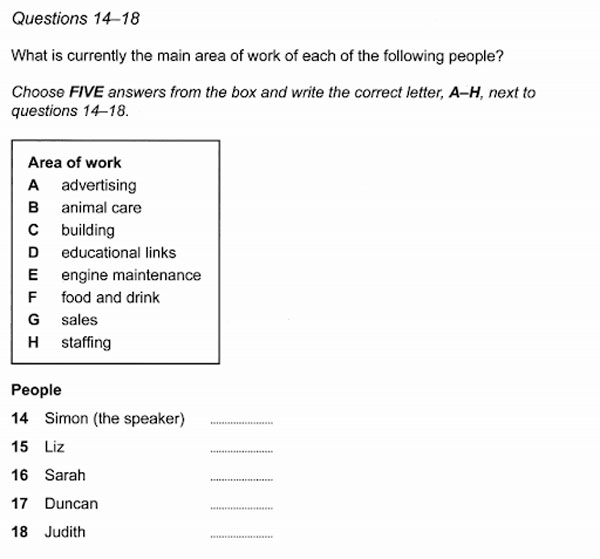
Fill in the missing parts or labels based on the listening. Skills tested include understanding spatial relationships and directions.
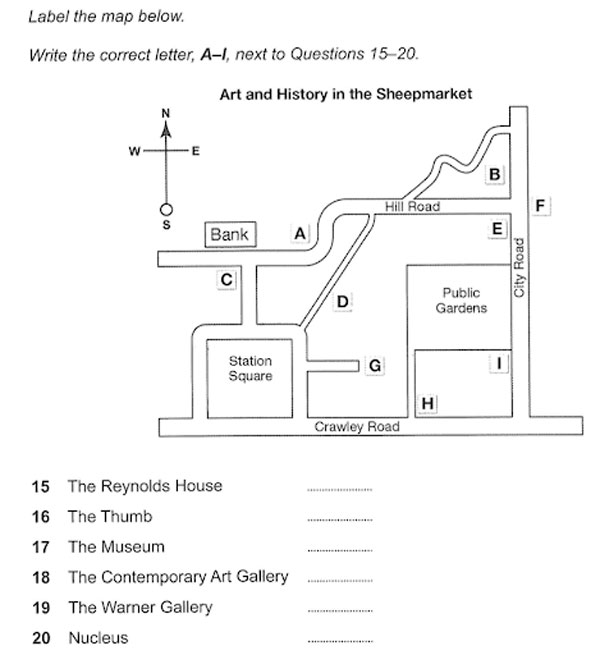
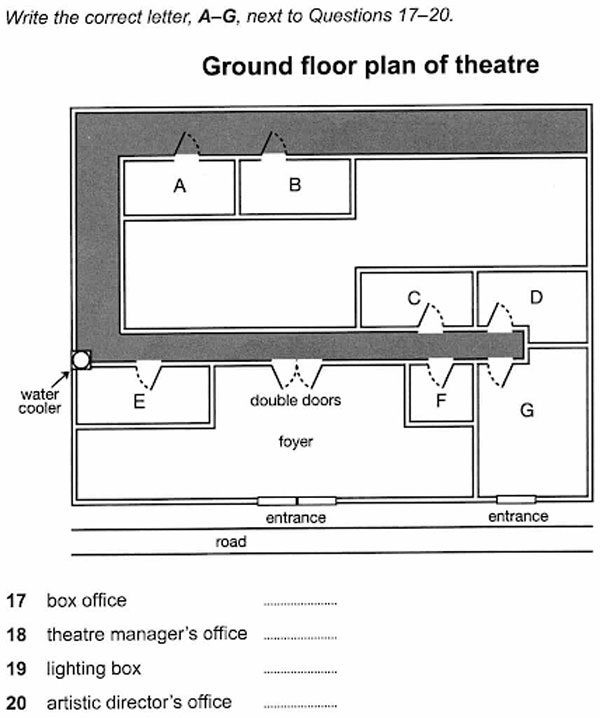
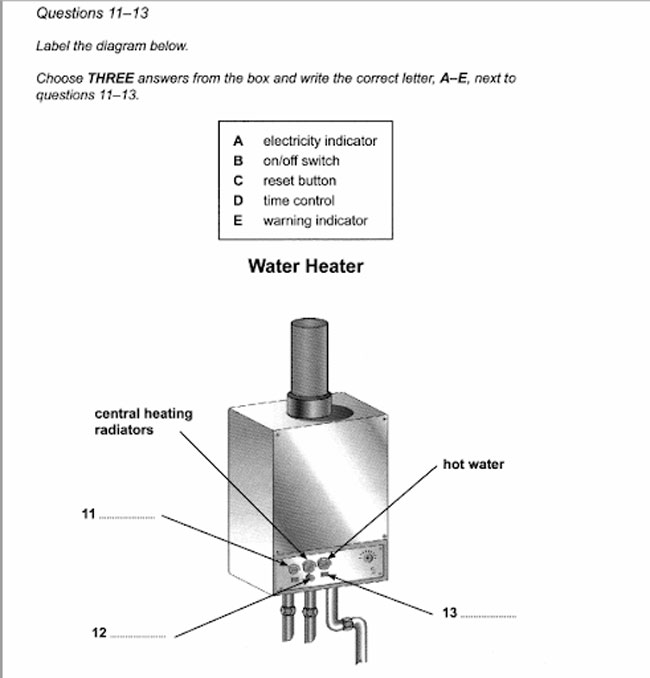
- Note, Form, Table, Summary, Flow-chart Completion
These are “completion” tasks such as Note Completion, Form Completion, Table Completion, Flow-chart Completion, Summary Completion.
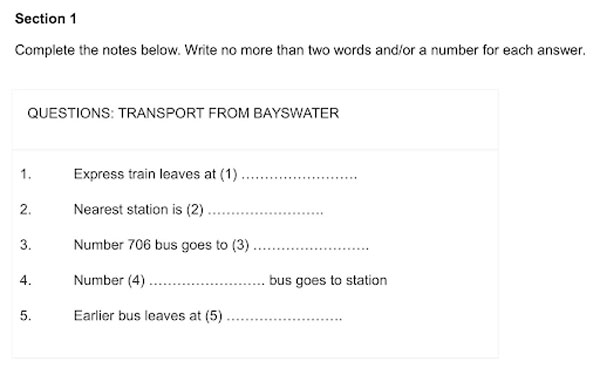
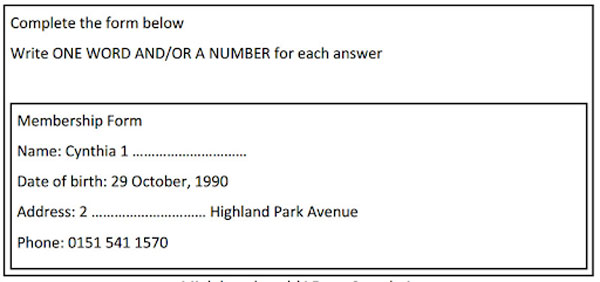
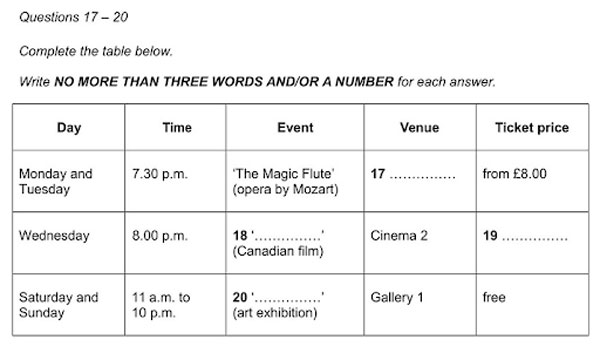
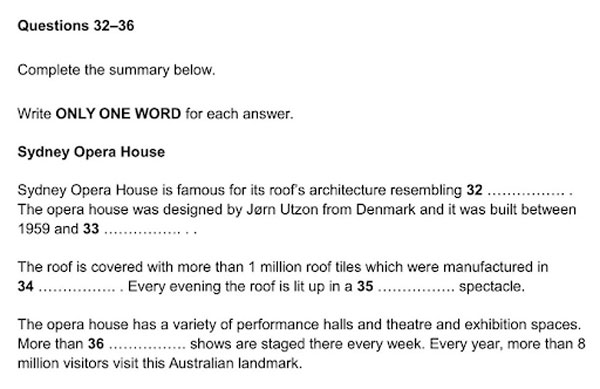
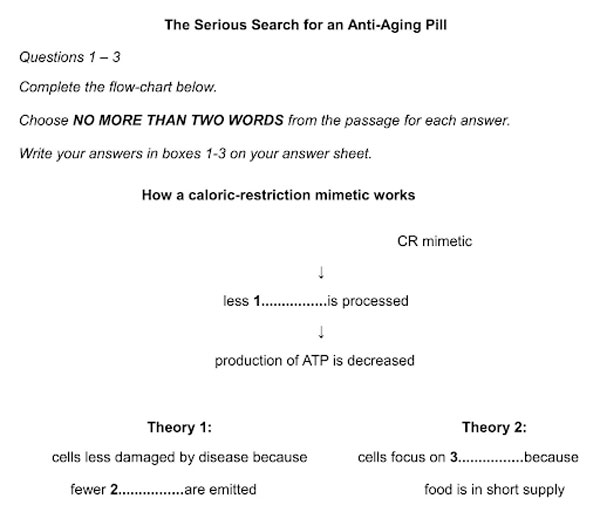
Fill the gap missing in part of the recording (or one recording) to test ability to follow sequence of information and capture precise meaning.
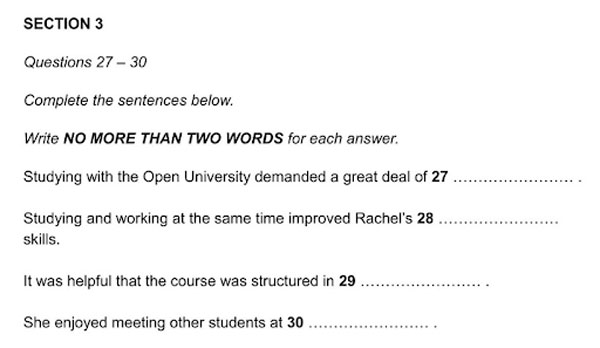
- Short-answer questions
Give a short answer (often one to a few words) using information from the recording, testing listening for specific factual details (places, times, numbers, etc.) and precise information.
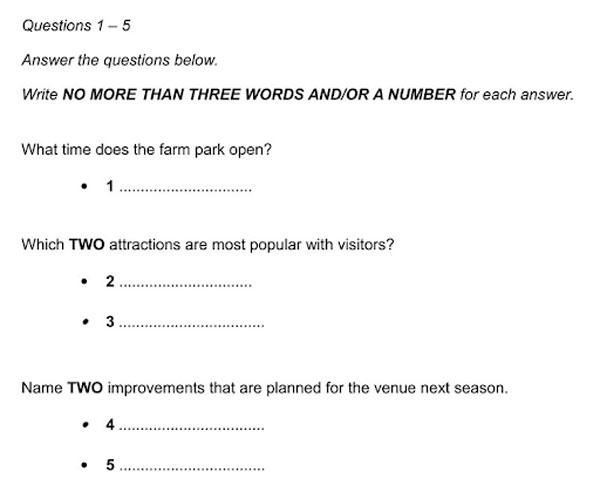
3. IELTS Listening Test Marking Scheme
The band score of IELTS Listening Test is applied for both the Listening Test of IELTS General Training and IELTS Academic, corresponding to the number of correct answers is illustrated in the table below:
| Band Score | Correct Answers |
| 9 | 39-40 |
| 8.5 | 37-38 |
| 8 | 35-36 |
| 7.5 | 32-34 |
| 7 | 30-31 |
| 6.5 | 26-29 |
| 6 | 23-25 |
| 5.5 | 18-22 |
| 5 | 16-17 |
| 4.5 | 13-15 |
| 4 | 11-12 |
Note: Many prep sites publish full conversion tables; however, IELTS emphasizes that precise marks may vary by test form. Treat any full table as typical, not absolute.
II. Common mistakes in Ielts Listening Test (with tips)
Even advanced learners lose points due to avoidable errors. At IELTS-TestPro, we emphasize not just hearing correctly, but answering correctly.

| IELTS Listening Common Mistakes | IELTS Listening Tips |
Candidates often tend to focus too much on waiting and looking for the answer to a particular question, which leads you to a state of bewilderment and dilemma in solving the question. As a result, you lose concentration and miss answers for the next ones. |
If you miss an answer, move on immediately. Use the end-check window (paper: transfer time; computer: 2-minute check) to guess intelligently based on context/grammar. |
The correct answers in the IELTS Listening Test depend much on the instructions, especially for the word limit. |
Read the instructions first, underline keywords (e.g. NO MORE THAN TWO WORDS) before jumping into the questions |
The Listening Test regularly consists of distractors in order to check the understanding as well as attentiveness towards the listening audio. Consequently, some candidates miss these distractors and get a wrong answer. |
Be careful with the contrastive words such as BUT, HOWEVER, NO, etc., and the speaker’s tone (emphasise, stress, slow down, etc.) |
This type of mistake is often made in the IELTS Listening test. The most common ones are the ending sounds (s, es, ed, etc.), name of people, street, etc. |
Spelling counts. Decide the part of speech before the audio; double-check plurals, hyphens, capitals in transfer/check time. |
Paying too much attention to answering the questions, some test-takers forget to predict the information before the audio starts. Hence, you may find it difficult to get the main content of the audio or give the correct word form for the answer. |
In the reading time before each part, predict word class (noun/verb/number), possible vocabulary, and units (km, $, %). |
A blank answer may result from wrong-place answers, which can lead you to lose your point. Besides, the predicted answer can be correct, so don’t miss any chances. |
Give an answer for the blank, even when you’re not sure about it. |
Try to avoid giving the answers on the answer sheet right at the time you are listening to the audio since you can be distracted or miss the information. Moreover, spelling and grammatical errors can be made while doing this process. |
Write on the question paper first, stay with the audio, and use the 10-minute transfer at the end to copy answers carefully. (On computer, you type as you go and get 2 minutes to check.) |
III. Effective techniques in IELTS Listening Test
To move from a Band 6.0 to a Band 8.0, passive listening is not enough. You need the structured approach recommended by IELTS-TestPro experts.

In order to score a high band in the IELTS Listening Test, you need to have a plan for improving your listening skills on a daily basis. These techniques are suggested by IELTS expert, teachers, and experienced test-takers to practice the IELTS Listening Test in the most effective way:
>> > Practice now: IELTS Listening Practice Test
-
Build daily listening habits (passive + active):
-
Passive: films, music, podcasts, radio, news – expose yourself without pausing.
-
Active: short focused sessions; summarize main idea + 2–3 details after each segment.
-
- Refer to authentic listening sources such as BBC, CNN, youtube channels (Ted talk, Ted ED, etc.)
- Practice with Dictation method in which you will you listen to a record and complete missing words or write down exactly what you have heard
- Always review the audio + script: highlight new words, note distractors, and record error types (spelling, speed, word class).
-
Format-smart practice:
-
On paper: simulate 10-minute transfer.
-
On computer: practice typing answers live and 2-minute end-check.
-
- Strategic safety net: If Listening is your only weak spot, consider IELTS One Skill Retake to retest only Listening (where available).
IV. Practice Application: Strategy Check
To verify your understanding of the IELTS Listening Test mechanics, complete the following quick-check exercise.
Question 1: The instruction states: “NO MORE THAN ONE WORD AND/OR A NUMBER”. Which of the following answers is ACCEPTABLE? A. 15th of June B. 15 June C. June 15th D. 15th June
Question 2: In a Multiple Choice Question, you hear the speaker mention Option A, then Option B, and finally Option C. Which strategy is most reliable? A. Select the option mentioned most frequently. B. Select the last option mentioned. C. Listen for “distractors” (but, however) and select the option that remains factually true after the speaker finishes. D. Select the first option mentioned to save time.
Question 3: What should you do during the 10-minute transfer time (Paper-based) or 2-minute check time (Computer-based)? A. Rest your eyes. B. Check for spelling, plural endings (s/es), and capitalization. C. Try to recall answers for questions you left blank based on memory. D. Both B and C.
Answer Key & Explanation
1. Answer: B (15 June)
- Explanation: “15” is a number. “June” is a word. This fits “ONE WORD AND/OR A NUMBER”.
- A (15th of June) = 3 words + number (Incorrect).
- C (June 15th) = While often accepted as a date format, strictly speaking, “15th” counts as a number combined with text suffix, but standard IELTS convention prefers “15 June” or “June 15” to be safe. However, strictly counting: “15th” is often treated as a number. But “15 June” is the safest adherence to the limit.
2. Answer: C
- Explanation: IELTS relies heavily on distractors. Speakers will often discuss all options but negate two of them using contrastive language. Never rely on position (first/last) or frequency.
3. Answer: D
- Explanation: This time is crucial for Quality Control. You must check grammar/spelling (B) and also make logical guesses for blanks (C) because there is no penalty for wrong answers—never leave a blank!
Ready to start your practice? Visit IELTS-TestPro today to access our full library of mock tests and personalized listening exercises tailored to the latest format.
The IELTS Listening test hasn’t changed in its core design – it still measures how well you understand English in everyday and academic contexts. But as of 2025, small yet important updates matter: Clear timing differences between paper vs. computer formats, and the new option of IELTS One Skill Retake if Listening is your only weak point. IELTS Online Test with manifold IELTS Listening Test will be an ideal option for you to practice and get a high score.